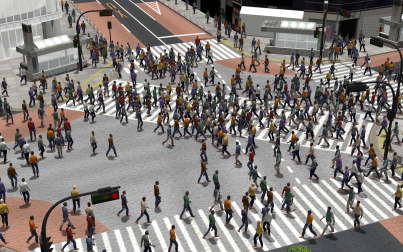Jamming, Arching, and the Wake Effect

In this simulation 50 simulated individuals are uniformly distributed on one side of a small corridor. The individuals are given goal positions on the opposite side of the passage. Several phenomena emerge, including jamming, the formation of a circular arch, and the wake effect.
Video: [MOV (12.6 MB)]
Edge Effect and Uneven Density

10,000 simulated individuals walk the same direction down a long corridor. The individuals are given goal positions at the end of the corridor. The individuals towards the center the crowd (e.g. those highlighted in orange) move slower than those towards the edge (e.g. those highlighted in purple). Additionally, pockets of uneven density form and dissipate as the crowd moves.
Video: [MOV (17.8 MB)]
Flow Rates
A comparison of the effect of exit width on the flow for real (dashed lines) and simulated (solid line) humans. Humans simulated with our Least Effort methods exhibit similar flow rates to real humans.
A comparison of speed vs density for simulated agents moving through a bottleneck. As the density of agents increases their average speed decreases. A similar trend is seen in real humans (as reported by Weidmann and others).
Shibuya Crossing
Comparison of the real and virtual Shibuya crossings. In the simulated crossing, 1000 simulated individuals are randomly distributed around the four corners of the intersection. Each agent is then given a goal of a random corner that they are not currently on.
Video: [MOV (36.7 MB)]
Hi Res Stills


Hi-res stills from a simulated trade show [PNG] and a simulation of Shibuya Crossing [PNG]
All Videos:
- Jamming, arching, and wakes [MOV (12.6 MB)]
- Edge and pocket effects [MOV (17.8 MB)]
- Smooth paths [MOV (5.6 MB)]
- Congestion avoidance (environment without obstacles) [MOV (10.7 MB)]
- Congestion avoidance (environment with obstacles) [MOV (36.7 MB)]
- Tokyo's Shibuya crossing [MOV (42.9 MB)]